Shipping containers, also known as intermodal containers, are one of the greatest innovations in the freight industry. They are used by carriers to store palletized goods, heavy materials, and even vehicles for transport on trucks, ships, and trains.
Shipping containers have revolutionized the industry by making intermodal transport possible. They simplify the transit process, reduce cargo handling, and improve security with the aid of powerful locking mechanisms.
However, when these containers are not in use, they can unnecessarily take up a lot of space, especially in facilities with limited space, like warehouses, production plants, and ports. As a result, stacking them is one of the most popular solutions for carriers, yard and warehouse operators, and production facilities.
The process involves lifting a shipping container with a crane or forklift, stacking it on top of another container, and utilizing the available vertical space. However, stacking shipping containers is a complicated and potentially dangerous process.
Therefore, it demands precision which is only possible with a proper mix of equipment, expertise, and strategy. In this article, we’ll share a detailed guide on how to stack shipping containers properly and safely, broken down into 7 easy-to-follow steps.
- Guide 1: Stacking Shipping Containers With Cranes
- Guide 2: Stacking Shipping Containers Without Cranes
Stacking Shipping Containers With Cranes
We have devised a comprehensive guide to stacking containers safely and effectively using different types of container-handling equipment. As such, we don’t recommend using equipment apart from the ones listed in this article as they can present different types of risks.
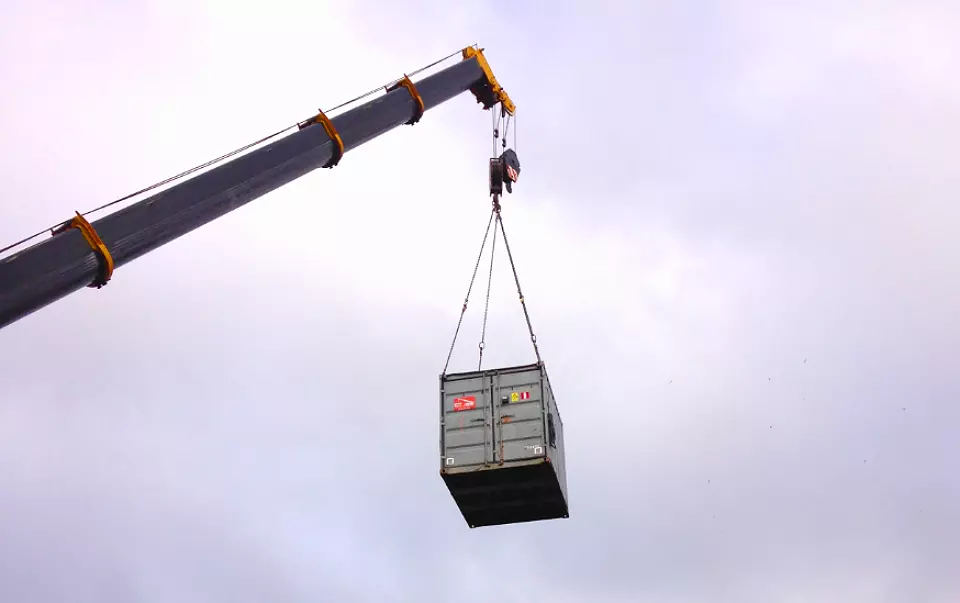
The most popular and efficient method of stacking containers involves using a port or gantry crane. Take note that not every warehouse or facility has cranes or the capital to rent them.
Step 1: Inspect The Stacking Location
The first thing you will need to do before stacking a shipping container is to inspect the stacking location for cracks and uneven surfaces. If you plan to stack containers on blocks or concrete castings, ensure the measurements match the container dimensions.
Next, you need to check the integrity of the ground surface and ensure that it’s completely flat, leveled, and firm. While checking the leveling can be easily done using a bubble-level tool, checking the firmness to withstand the weight of a stack of containers may require professional tools and help.
While you may not have to worry about height restrictions when stacking containers, yards generally don’t stack more than 5 – 7 high for empty containers. Take note that you should always exercise caution and establish the maximum stacking height by considering the following factors:
- The structural integrity of the foundation
- The maximum stack load of the lowest container
- Location limitations
- Environment (heavy winds)
- Equipment (forklift/crane) limitations
- Height from the ceiling (if indoors)
- Crane operator’s handling skills
Once you’ve taken care of these aspects, you need to consider pre-planning the stacking arrangement, especially if you’re stacking different container sizes.
Important Note: Never stack different container sizes ontop of each other. For example, only stack 20' containers ontop of other 20' containers. The same applies for 40' and other container sizes. We do not recommend to stack laden containers.
Step 2: Inspect The Shipping Container
From a safety perspective, the next and perhaps the most important step involves checking for any structural compromises in the container you’re planning to stack, such as dents, cracks, and any other damages in the sub-flooring and corner castings.
Once you’re done, check if the container has any cargo within and unload it before stacking. It is highly recommended not to stack laden containers. Next, check if the container doors are properly shut and arrange each container in ascending order in terms of stack load capacity.
Doing so will reduce the risk of collapse caused by compromises on any of the container’s structural integrity. Below is a simple container checklist you can use to accelerate the inspection process:
| Part | Inspection Areas |
| Interior | Check for dents and holes (undercarriage too if possible) |
| Doors | Check locks and locking mechanism, no loose bolts and hinges are functioning |
| Walls | Check for structural damage |
| Ceiling | Check for structural damage |
Step 3: Attach & Secure the Crane to the Corner Castings of the Container
Following the inspection and safety check, you need to position the crane perpendicular to the container so the lifting would be directly above it. While port cranes are equipped with a spreader, gantry cranes and other types of cranes typically include a lifting hook.
Facilities using cranes with lifting hooks generally attach a lifting chain sling at each corner casting and connect it to the crane hook. The chain’s length depends on the container’s length (20ft/40ft), so ensure you are using the right ones.
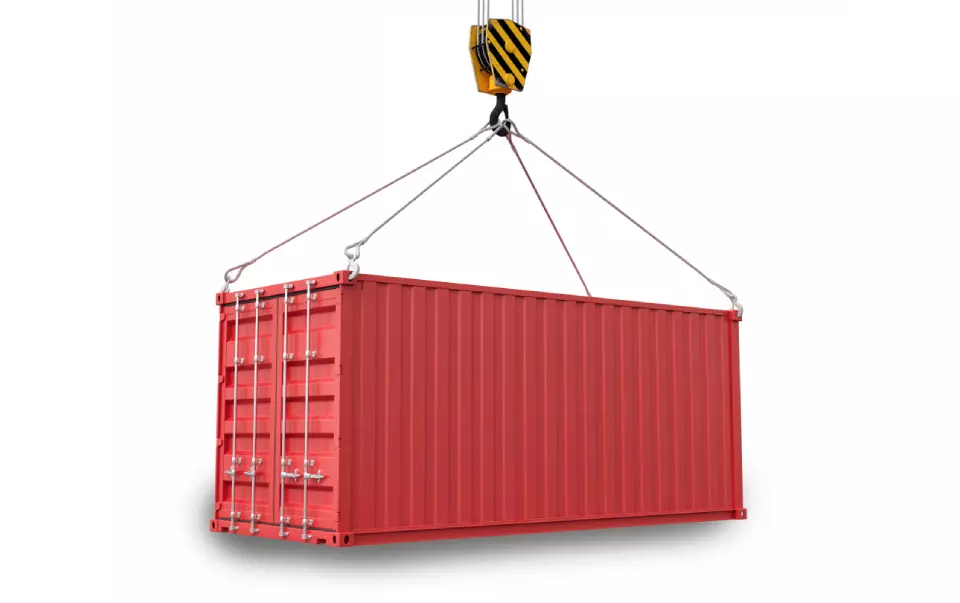
For extra precaution, slowly lift the crane such that the container hovers over the ground, and hold it in that position to verify that the connections are secured and that the container is not swiveling.
If you’re unsure if the connection is secure, lower the crane, inspect the issue, and reattach chains to the corner castings. Similarly, when using cranes with a spreader, lower the spreader above the container and secure it using twist locks.
Step 4: Align Container to Stacking Location
Once the container is hooked or attached to the crane, slowly move the crane until the container hovers over the stacking location. The most important step here is to ensure the corner castings align with the castings of the container below.
Make sure the four corner castings align with the concrete casting or supporting blocks for ground stacking.
Step 5: Slowly Lower the Container While Maintaining Alignment
Once the container is in position, lower it slowly and steadily to maintain the alignment. You don’t have to lower the container in one take. You can pause, adjust, and check at periodic intervals as you lower the container.
Not stacking the container in the desired position will increase the risk of toppling. Therefore, take your time and have a guide visually check all corners of the container while you operate the crane. Once the container is in place, you simply need to ensure it’s stable.
Step 6: Inspect the Stability
As mentioned above, you must check whether the container you stacked is structurally intact. During the inspection, make sure the containers are:
- Completely centered (not leaning towards any side)
- Fully aligned (no protrusion or misalignment)
Step 7: Detach Attachments & Crane from the Container
Finally, once you’re confident that the container is well-positioned and stable, you can proceed to detach all attachments. If you’re using a spreader, simply unfasten all four twist locks from the corner castings for the spreader.
If you’ve used a hook, then you’ll need to unhook the four chain hooks or lugs from each corner casting. Once the container is detached, you need to carefully move the crane and ensure no chains or equipment gets caught onto any part of the container or stack.
Stacking Shipping Containers Without Cranes
As mentioned in the previous section, you can use other types of handling equipment to stack shipping containers. The most popular examples include heavy-duty forklifts, straddle carriers, and reach stackers.
Below, we have created a simple guide on how to stack containers using each of these equipment types:
Using a Heavy-Duty Forklift
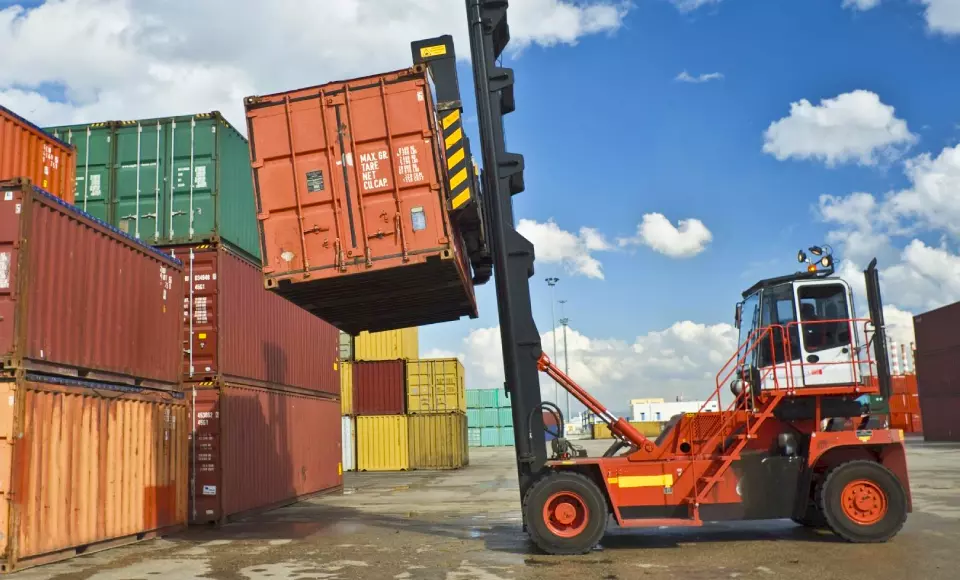
Heavy-duty or high-capacity forklifts, like the Toyota High-Capacity IC Pneumatic Forklift or Caterpillar’s CAT 2C3000, are internal combustion engine-based forklifts with lifting capacities from 19,000 to 105,000 lbs. These types of powerful forklifts can easily be used to stack laden or empty containers.
They are commonly used in container yards, ports, and warehouses where stacks don’t exceed more than two to three containers.
Below is a guide on how to stack containers using forklifts:
- Before using the heavy-duty forklift to stack shipping containers, you must inspect the stacking location along with the container’s condition to ensure they don’t topple. Refer to the earlier steps in the main guide above for more details.
- After the inspection, step into the forklift and position it perpendicular to the container. Ensure you have someone to guide you as you steer the forklift into position.
- All ISO container manufacturers in the market include dedicated forklift pockets at the bottom of containers. Once you have the forklift in position, you simply need to align it with the pockets and lock the pins.
- Once the pins are aligned and locked, you can start lifting and moving the container around. While stacking, ensure you align the container according to the corner castings of the lower container or the blocks/concrete castings on the ground.
- Once you’ve stacked the containers, remove the pins and steadily pull away until the forks come out of the pockets.
Using a Reach Stacker
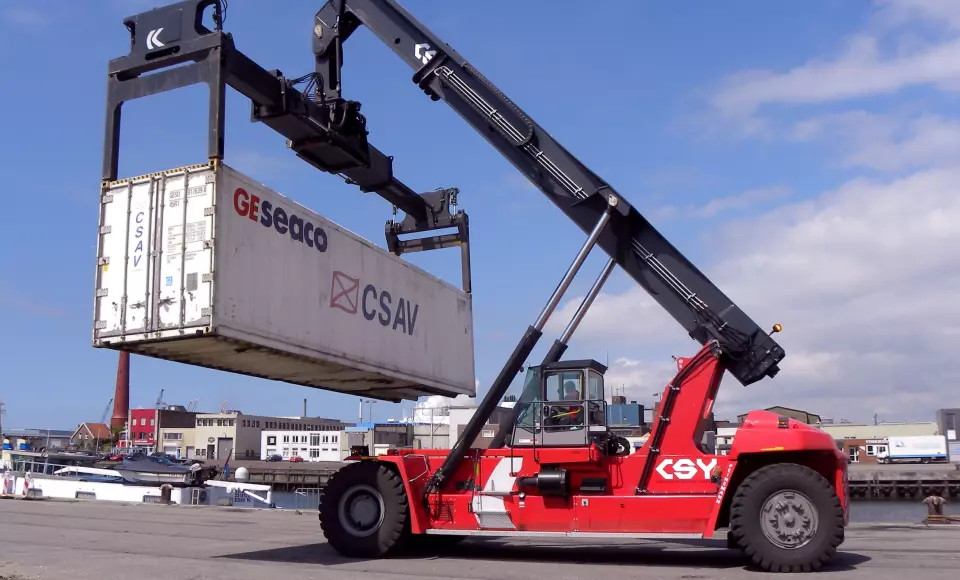
Another popular equipment type many facilities use to stack shipping containers are reach stackers. A reach stacker is a dedicated container-handling machine that functions like a crane.
However, it has a spreader at the end of its boon. This powerful piece of machinery can stack containers up to seven high. Reach stackers are commonly used for handling intermodal shipping containers at terminals and ports.
As a result, many manufacturers, including Toyota, Kalmar, Caterpillar, and Mitsubishi offer these crane variants as one of their top offerings since they provide more stability and accuracy when stacking containers.
Below is a simple guide to stacking containers using a reach stacker:
- As with any other method, the first thing you need to do is inspect the stacking location and container condition. Refer to the earlier steps in the main guide above for more details.
- Once you’ve done that, you can proceed to position the stacker perpendicular to the container.
- Next, using the hydraulic controls, carefully hover the spreader until its corners align with the container’s corner castings. Once the spreader is in position, set it down slowly until the hooks are in a position to attach with the castings.
- Once attached, slowly lift the container and place it on blocks/concrete castings or on top of another container. Finally, detach the spreader from the container and drive the stacker away.
Using a Straddle Carrier
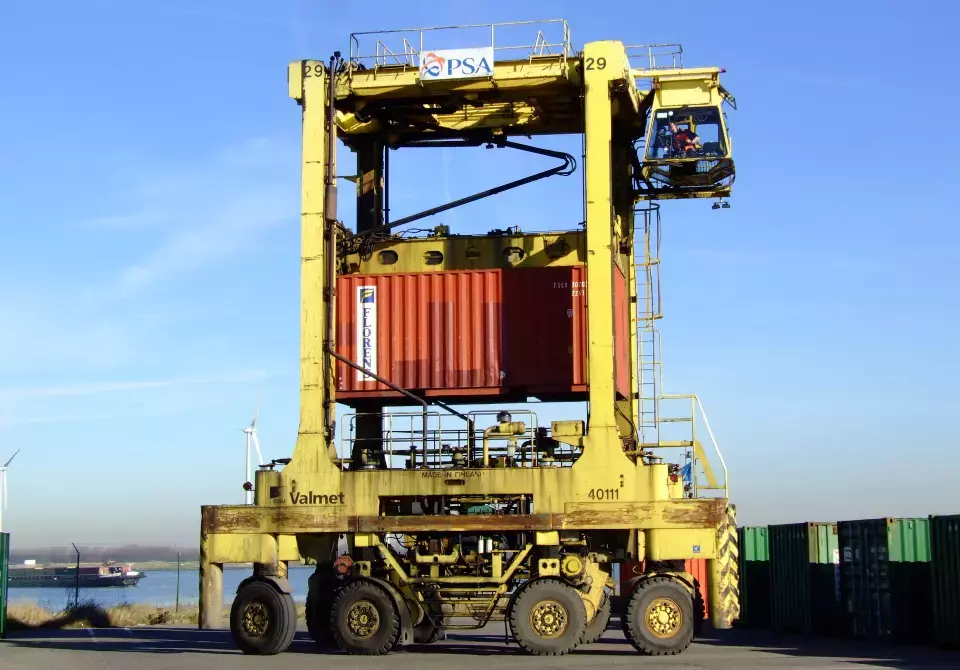
Straddle carriers are one of the most complex pieces of machinery used for lifting and stacking shipping containers. Due to their size and cost to procure and operate, straddle carriers are mainly used in large ports.
One of the key benefits of a straddle carrier is that it can stack up to two containers at once (similar to reach stackers).
Below is a guide on stacking shipping containers using straddle carriers:
- The first step revolves around a due diligence check. Start by inspecting the stacking location and all container conditions. Refer to the steps in the main guide for more details.
- Secondly, inspect the carrier and ensure there’s no structural or hydraulic damage. Check underneath the straddle for any fluid leaks.
- Then, slowly drive to the container and position the straddle legs between the container’s sidewalls from the front or rear-end frame. Make sure you account for all blind spots in your way and change your seat position frequently to maximize visibility.
- Once you’re directly on top of the container, use the hydraulic controls to descend the spreader slowly.
- Next, attach the straddle to the container’s corner castings and start lifting.
- Once the container is attached, you can drive it to the desired location and stack it on top of one another or the designated blocks/concrete castings.

Get Free Course Access
If you enjoyed the article, don’t miss out on our free supply chain courses that help you stay ahead in your industry.

Gerrit Poel
Co-Founder & Writer
at freightcourse
About the Author
Gerrit is a certified international supply chain management professional with 16 years of industry experience, having worked for one of the largest global freight forwarders.
As the co-founder of freightcourse, he’s committed to his passion for serving as a source of education and information on various supply chain topics.
Follow us